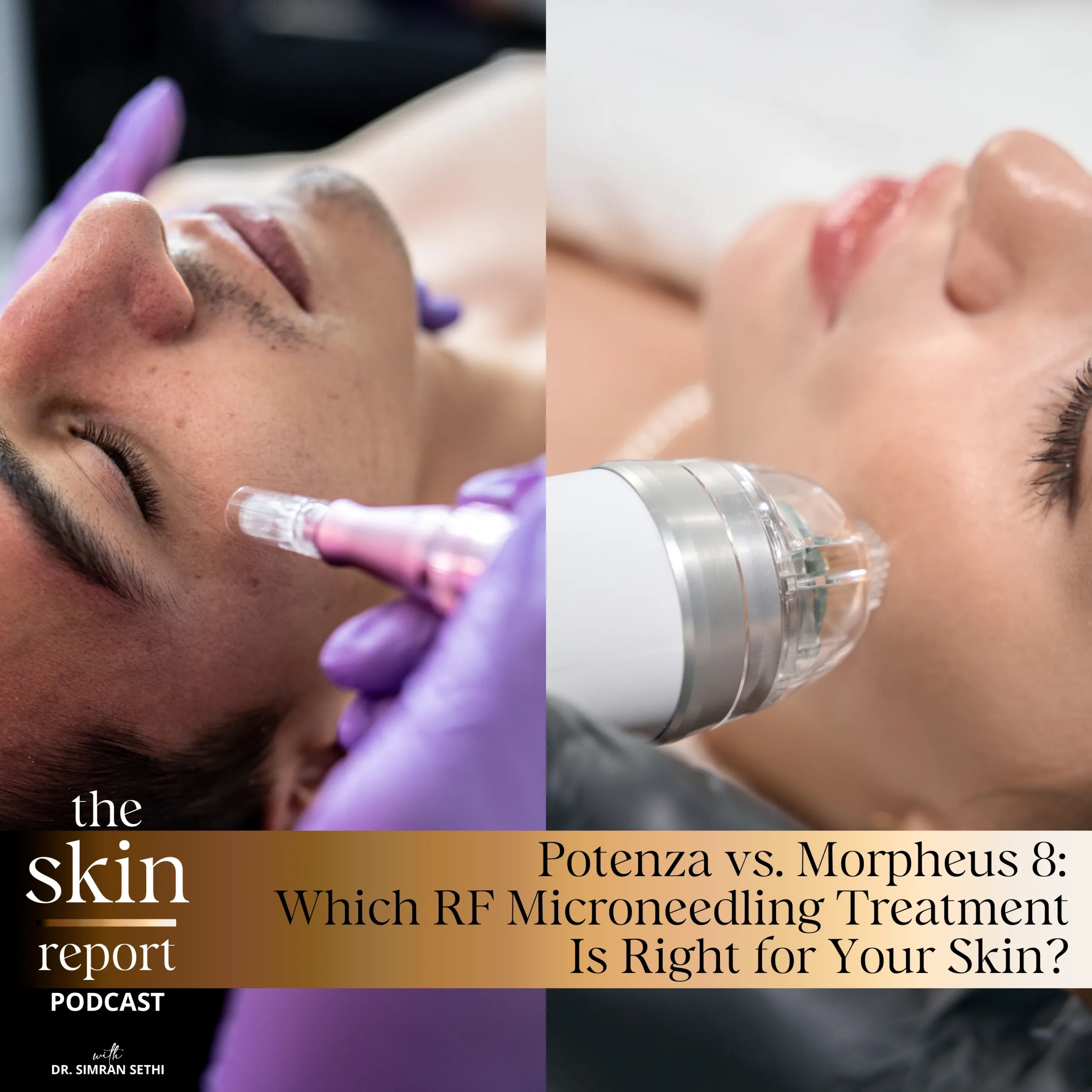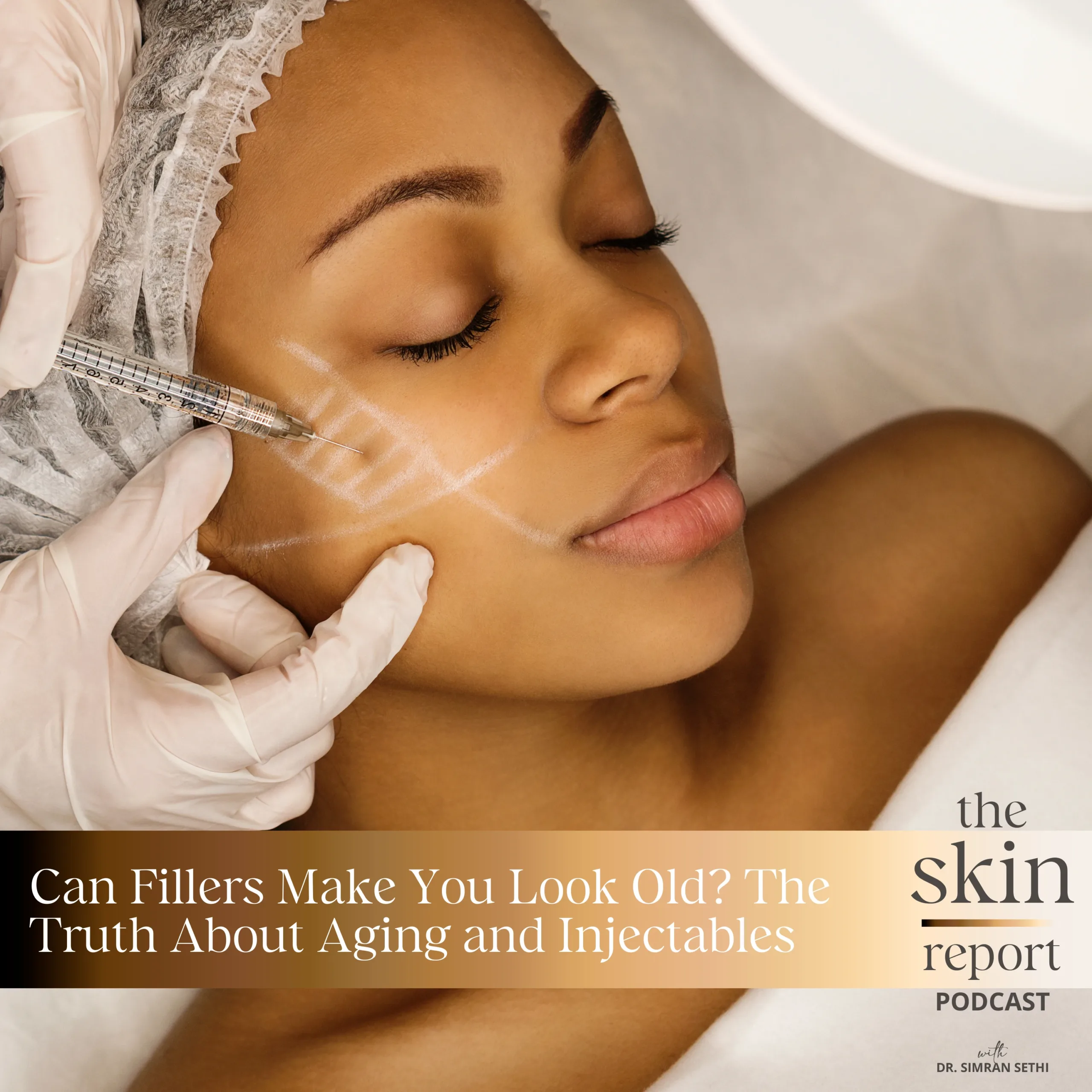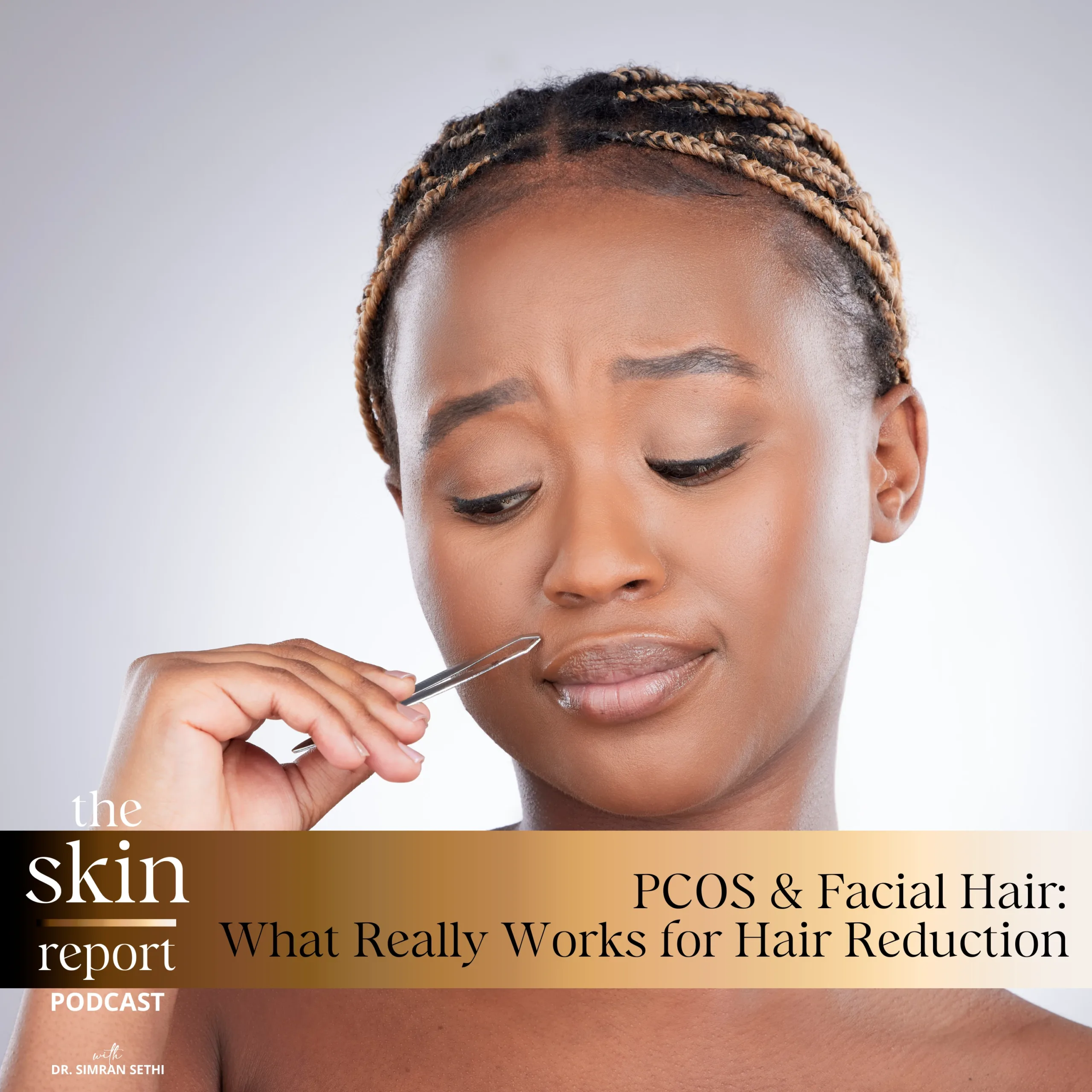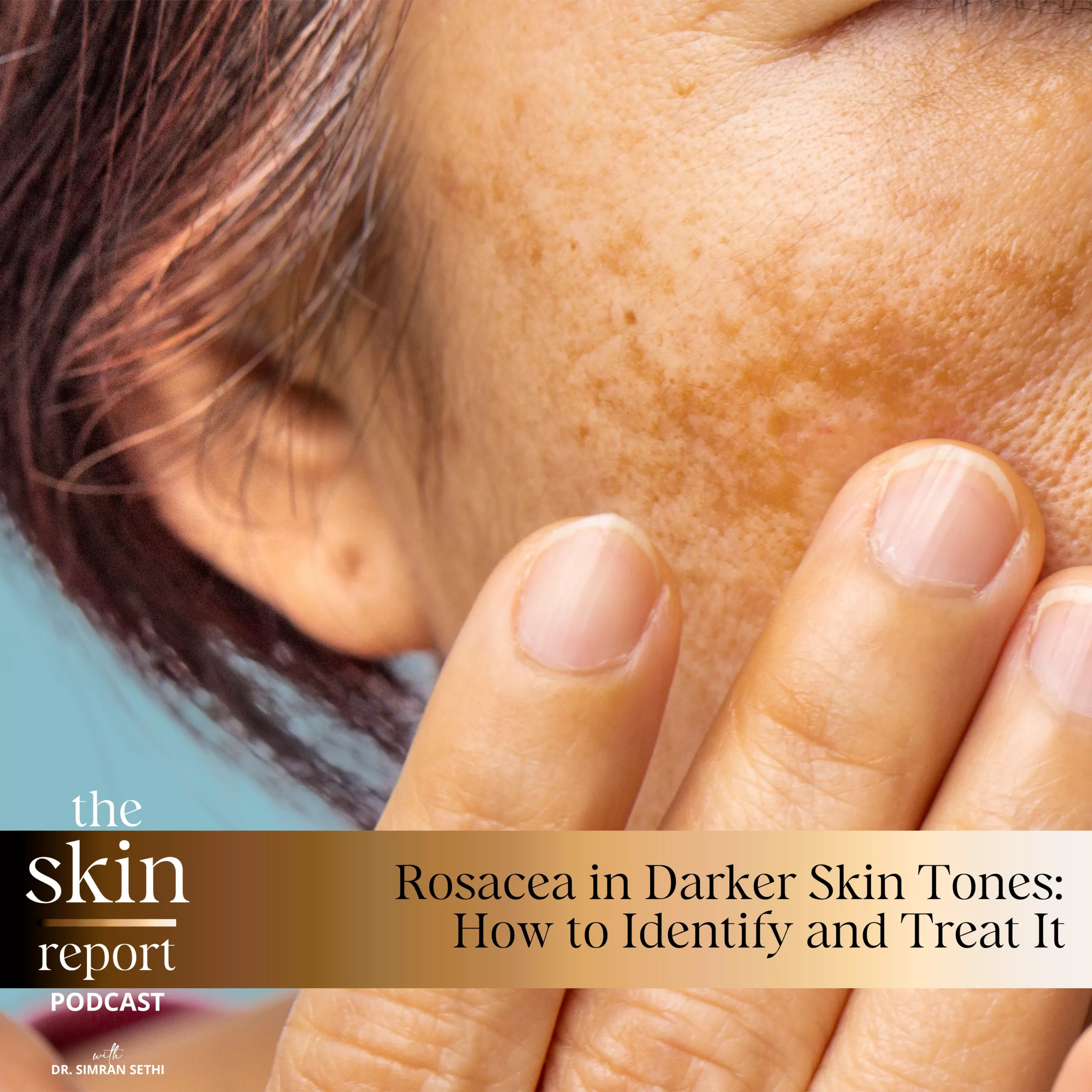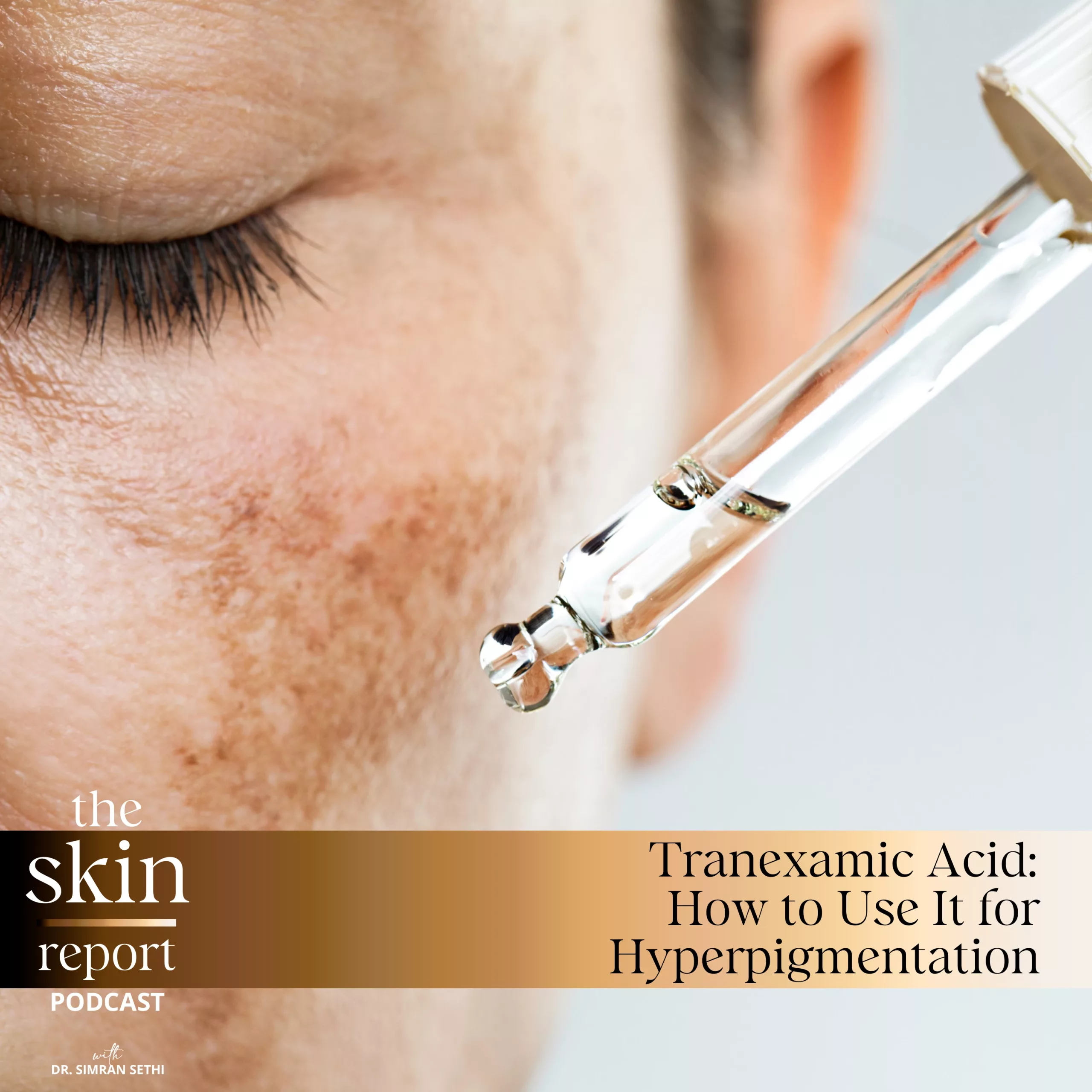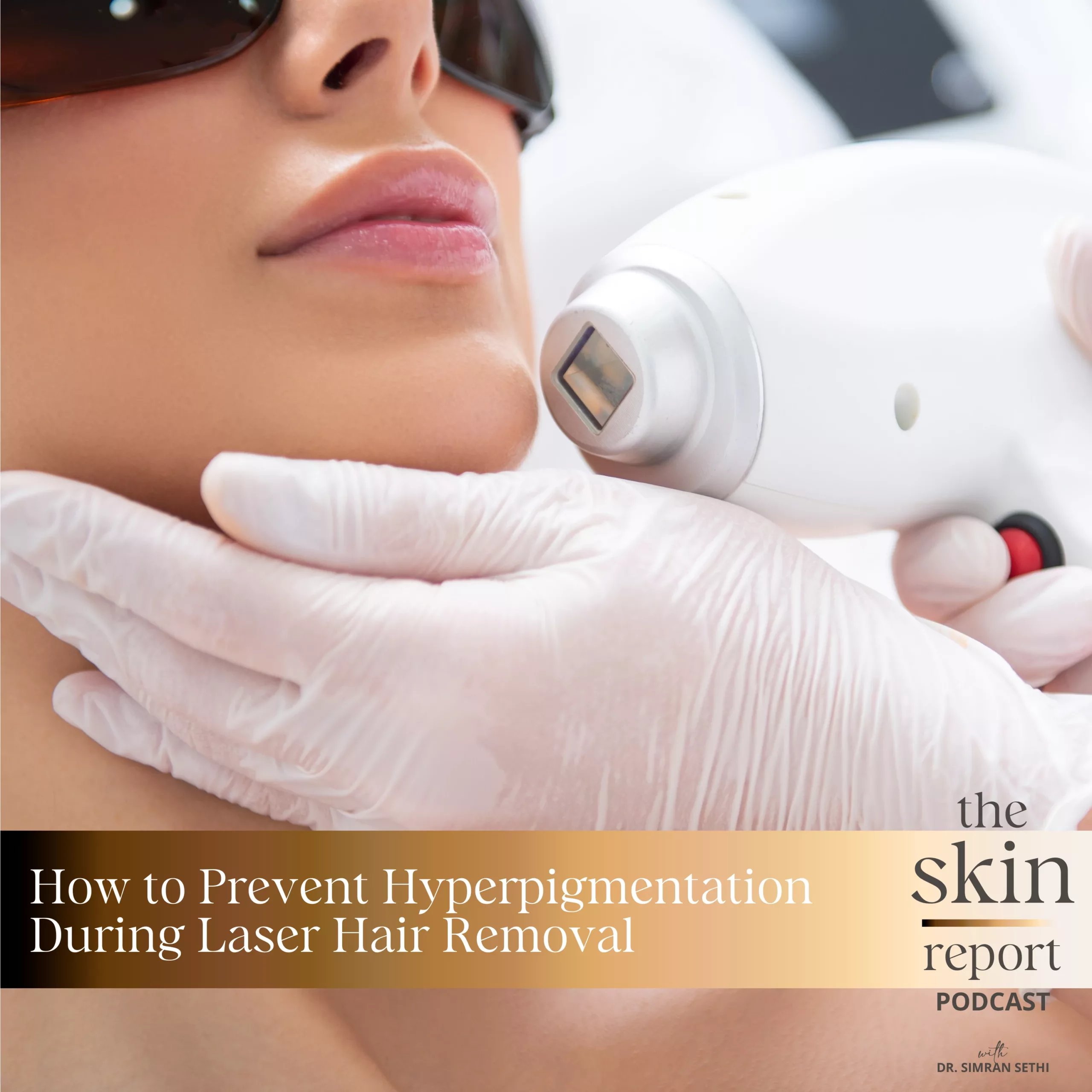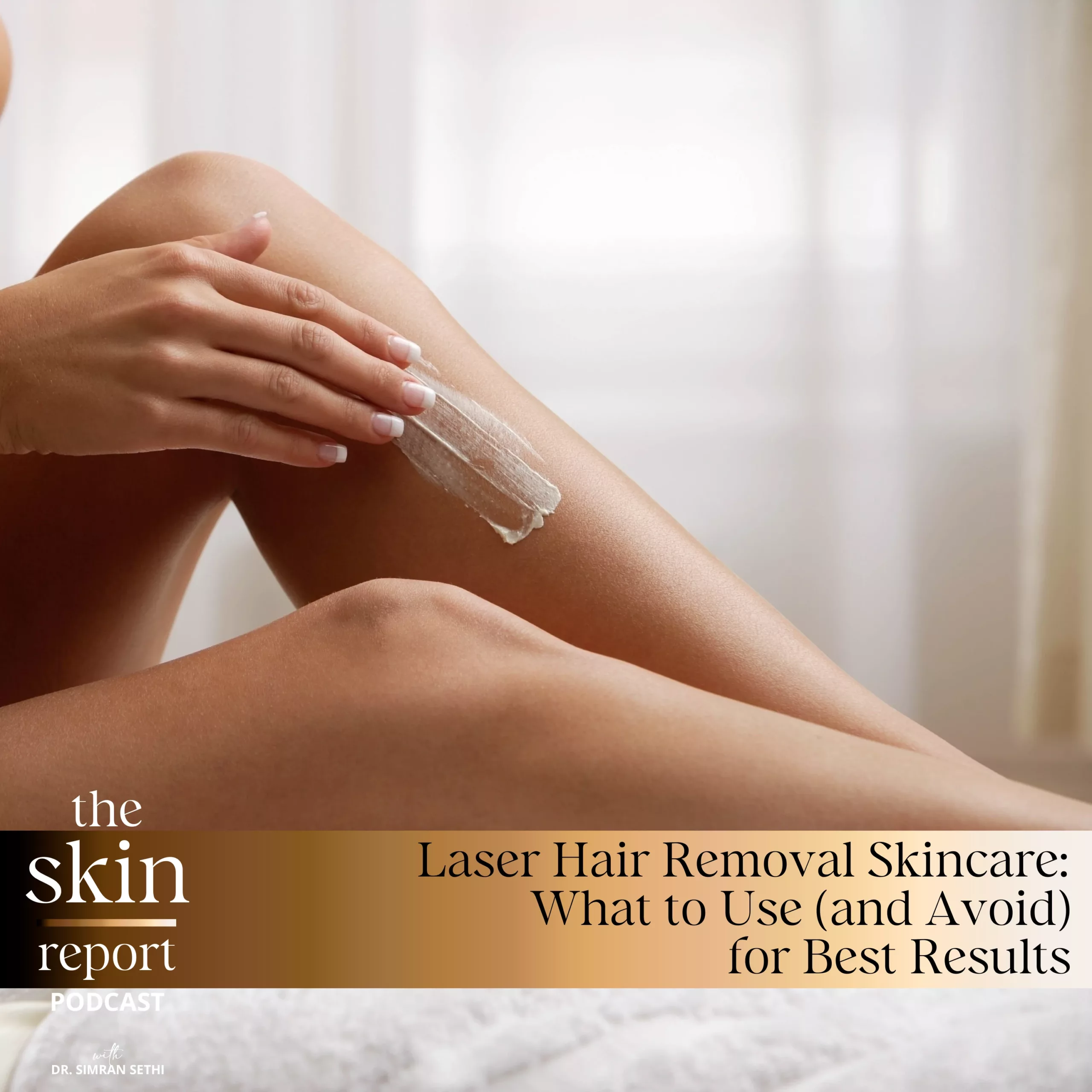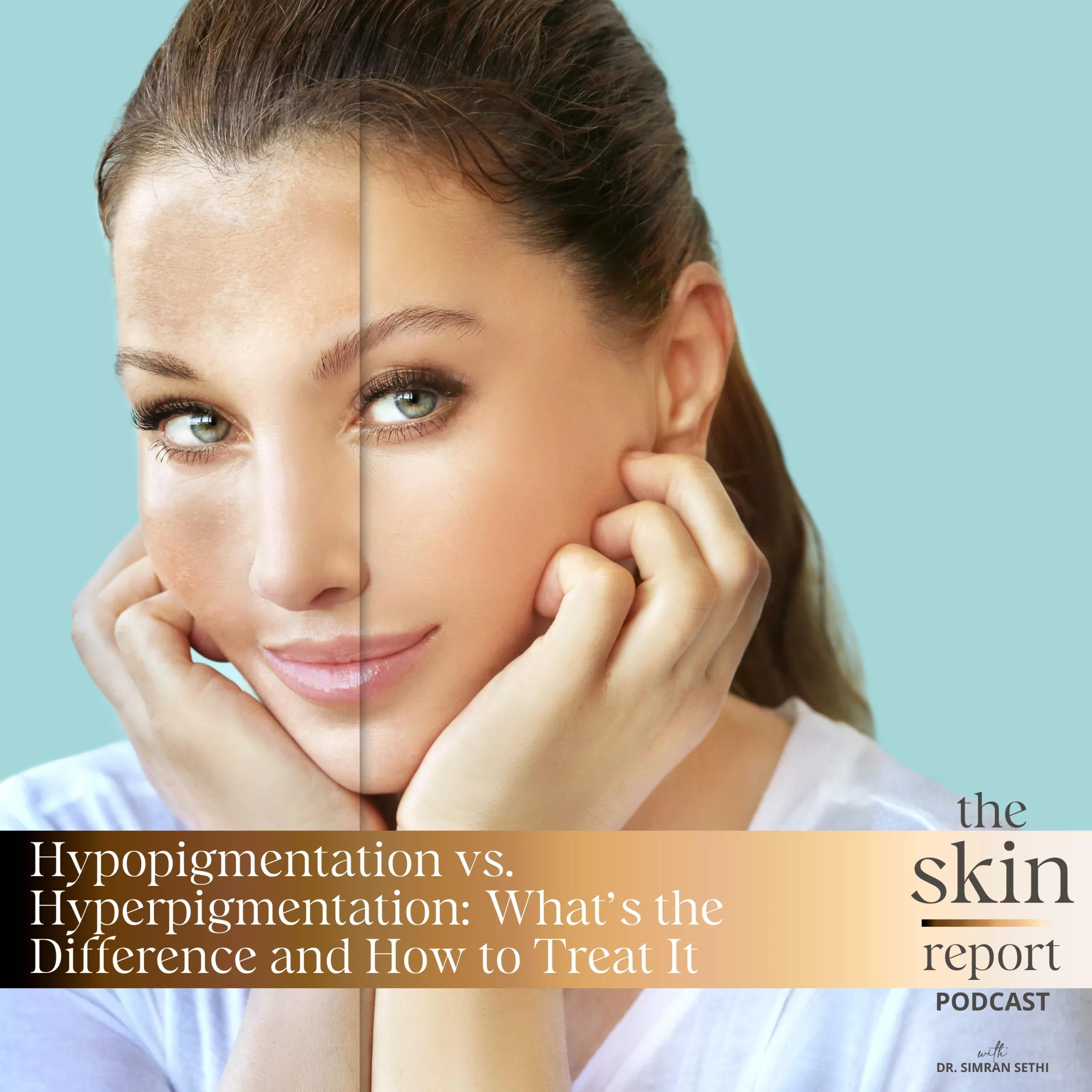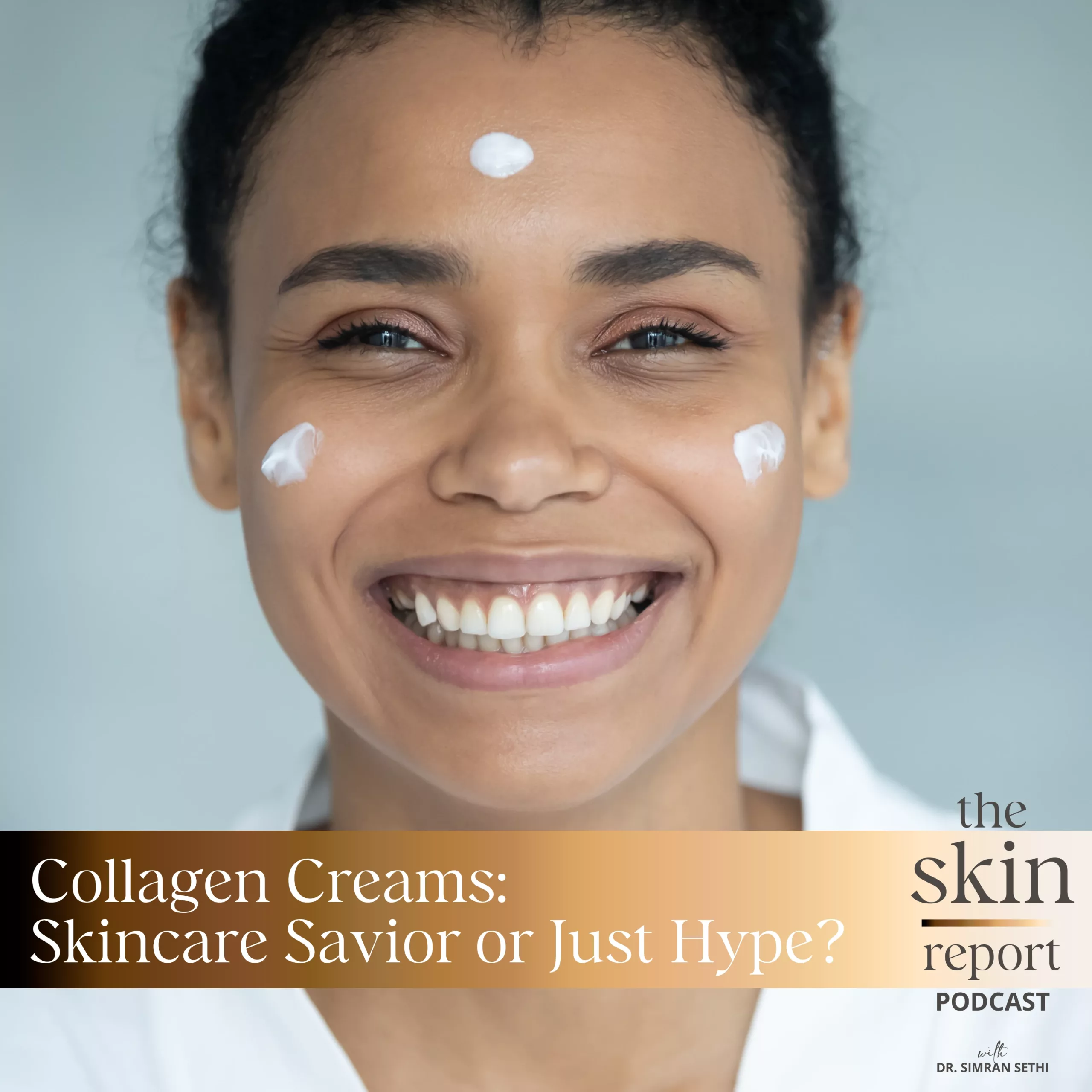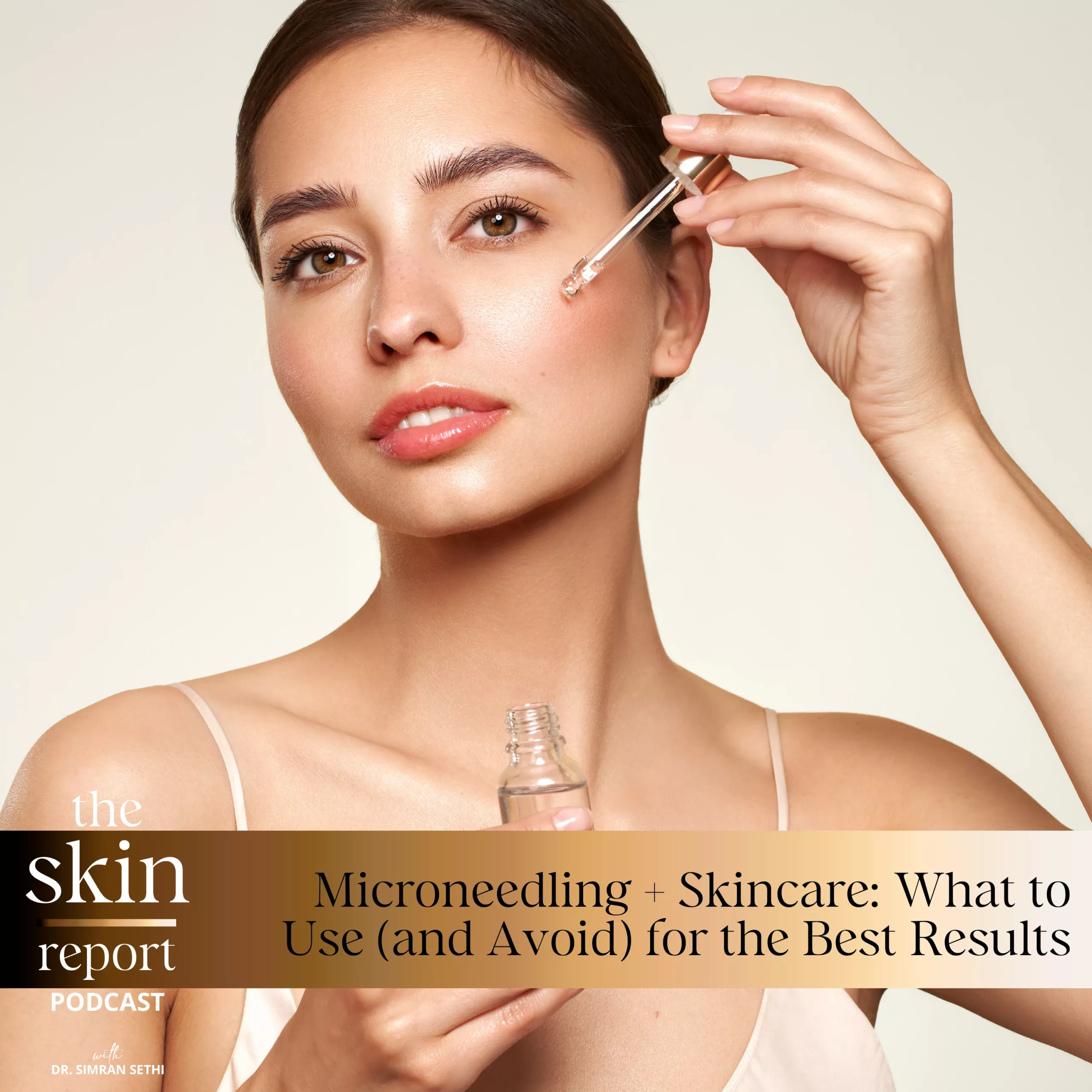Everyone has a natural exfoliation process to remove dead cells from the skin as a part of our skin’s renewal cycle. However, people exfoliate at different rates, and sometimes various factors can hinder our natural skin renewal and cause undesirable effects like blemishes and uneven skin texture. Fortunately, we can aid our skin’s exfoliation process by providing extra exfoliants to smoothen skin and help it glow.
The Skin Report is a podcast created to educate listeners on methods to improve skin health for people of all ethnicities and ages. On this episode, host Dr. Sethi teaches listeners all about the various kinds of skin exfoliants and healthy exfoliation practices. Different skincare exfoliating treatments can have different effects on the skin, and the type of exfoliant you use and the frequency at which you use it are all important to ensure the safety and health of your skin. In addition, Dr. Sethi discusses the difference between physical and chemical exfoliation, the benefits of exfoliating, and additional information on everything they need to know to incorporate exfoliation into their skin care.
Beauty Instagram: https://www.instagram.com/renewmd_beauty/
RenewMD Beauty Medical Spas, California: https://renewmdwellness.com/
This transcript was exported on August 16, 2022 -view latest version here.
Skin care can sometimes feel overwhelming, whether it’s finding the right products, ingredients, or treatments. There’s a lot out there. But not always for women of color. That’s why I set out to educate myself and others so that we can all feel beautifulin our skin. Hello and welcome to the skin report. I’m Dr. Simran Sethi, an internal medicine doctor, mom of three and CEO and founder of RenewMD medical spas, and Skin by Dr. Sethi. Today, I want to delve into the different types of exfoliants, what theyare and what they can do for your specific skin type and tone.
Before we outline the different exfoliants, I want to first tackle why we exfoliate. Our skin has a renewal cycle, which means that our skin is continuously sloughing off old skin cell layers from its outermost surface to make way for newer skin. Depending on your age, we produce new skin at different rates. For example, younger people make new skin cells at a rate of every week, whereas people in their 40s may take four to six weeks to make new skin. If you’d like a refresher on the skin renewal cycle, or just learn more about it, check out our very first episode on the Skin Report podcast.
So where does exfoliation come into play? Everyone actually has a natural exfoliation process. Our skin will remove these dead skin cells. However, depending on our age and other factors, we all exfoliate at different rates. In younger people who are more acne prone, their skin tends to not exfoliate at a rapid enough rate. And as a result, dead skin and debris gets mixed with sebum and clogs their pores to create pimples. Even as we age, our natural exfoliation process may not be efficient enough to get rid of all the dead skin cells. Factors out of our control such as pollution can often interfere with our skin renewal process and its effectiveness. Therefore, we must help our exfoliation process by providing extra exfoliants.
No matter your skin type or tone, exfoliant accomplishes two important goals. It removes our dead skin cells to give a more radiant, clearer glow. And most importantly, it improves skincare product penetration. This second point is something most people are not aware of, but in my opinion, is equally, if not more important than point number one. In fact, I always recommend a monthly facial that includes some sort of microdermabrasion to remove the dead skin cell layer off to optimize product penetration throughout the month.
Exfoliation in general can also help to reduce the appearance of acne scars, hyperpigmentation, and more. Removing dry and dead skin over time smooths out your texture as well as evens out the skin’s appearance. And as I said, the exfoliant will help other products penetrate the skin more, thus helping to target other skin insults better. Exfoliating can have other benefits that happen below the skin that leave you feeling your best on the inside and out. By removing dry dead skin cells, you can boost your circulation and increase cell turnover, meaning that your fresh healthy skin cells will be at the surface of your skin.
Some studies have shown that long term exfoliating can increase collagen production, leading to glowing vibrant skin. But remember, these studies have been done primarily on lighter skin tones. With darker skin tones, taking a more conservative approach to exfoliation has been shown to be safer and has better yield. Many people are catching onto the numerous benefits of exfoliating. In 2020, The NPD Group found that 22% of US women have changed their skin care routines during and possibly because of COVID. A part of this is the incorporation of exfoliants into their skin care routine.
When it comes to how many times you should exfoliate per week, that depends on which type of exfoliant we are discussing and your skin type and tone. We’ll dive into that later on in this episode. So without further ado, let’s go into the different types of exfoliants. First, I want to discuss physical, otherwise known as mechanical exfoliants, which may be the first thought that comes to many of our minds when we think of exfoliants. This type of exfoliant mechanically breaks down bonds between of 5dead skin cells and debris to polish off the dead skin layer. In order to accomplish this polishing, this exfoliant uses small particles or granules to buff away dead skin cells.
They tend to be the scrubs that populate the shelves of drug stores and makeup outlets, using particles of different sizes, such as ground up apricot seeds or rice particles. Even a face cleaning brush, like the Clarisonic brush is considered a mechanical exfoliant. Finally, a microdermabrasion facial is a more intense form of mechanical exfoliation, but should only be done once a month. I’m not a fan of the at-home microdermabrasion machines that encourage people to perform this as frequently as weekly, as the overuse will do more damage to the skin, especially if you have more melanated skin. Your skin will feel rough, patchy, and even flaky. Your other products may not work as much on your skin if you over exfoliate.
Even if you’re not getting this facial, you’ll want to consider how frequently you should use a mechanical exfoliant. No matter how oily your skin may be or how gentle the exfoliant is, you should not use it every day. Otherwise, you will strip your skin of essential oils and moisture and irritate it. Start by using a physical exfoliant one to two times a week for a month until your skin has adjusted. Then you can start building up to three to four times a week. I would not go beyond this, as more frequent mechanical exfoliation can strip down your skin’s protective lipid barrier, no matter how gentle the product is.
If you’re getting a medical grade skin resurfacing procedure, such as the ones we discussed in episode seven, you shouldn’t do any exfoliating the week before and after the procedure. One week after your procedure, you can begin exfoliating one to two times a week, as you will have started producing new skin at a rapid rate, thus needing dead skin cells to be removed. However, we also want to keep our lipid ridge skin barrier intact andstrong. So striking a balance in exfoliation for this particular group is important.
Overall, mechanical exfoliants are safe and effective to use. However, like frequency, the size of the particle is an important factor in achieving healthy and clear skinwith mechanical exfoliation. For melanated skin, the particle size is the most important consideration. Products with large particle sizes such as St. Ives apricot facial scrub are too harsh, and as a result, create micro-tears in the skin. Today, even though the St. Ives facial scrub is not as popular, it has been replaced by some other brands that are equal culprits. Micro-tears directly irritate the epidermis and stimulate more melanin production, and as we’ve discussed on the show before, leads to excess pigment production in darker skin tones.
If you’d like to learn more about what melanin does for the skin and how this impacts darker skin tones, check out the second episode of the Skin Report. It’s helpful to know the science behind how our skin worksso that we can make more informed decisions when buying skincare products that are unfortunately not always made with darker skin tones in mind. Even still, there are many products out there that are too harsh for all skin types. But how do we know if your favorites are too intense? I would avoid exfoliants that use salt, nuts, fruit pits, volcanic rock, synthetics.
I want to mention that synthetic microbeads made of polyethylene were found to be too small to filter out of waste water and polluted ocean life and even people. President Obama signed the Microbead-Free Waters Act of 2015, banning manufacturers from using these plastic microbeads. Any older products you may have that contain these beads should be thrown out. Some examples of safe particles thatare ground down to small size include oat or rice bran. These are safe for all skin tones. And because they’re natural, the chances of allergies to them is also minimal.
Chemical exfoliants loosen up chemical bonds that help bind dead skin cells together so that they can slough or wash off the skin more effectively. The most common chemical exfoliants available in skincare products are alpha hydroxy acids like glycolic or lactic acid and beta hydroxy acid like salicylic acid. We spoke briefly about how to incorporate AHAs and BHAs into your wedding prep on episode 10 of the Skin Report. I highly recommend checking that episode out, even if you’re just going to be a wedding guest anytime soon. Using such ingredients can break down the enzymes in dead skin cells to help dissolve them, which can minimize the look of pores as a result. They’re a great way to help smooth and refine our texture, brighten skin and boost skin cell turnover as we’ve said.
Depending on the concentration in a product, they can either be gentle or strong. A chemical peel, for example, is a very strong version of a chemical exfoliant. While a strong exfoliant has more power to it, it can also strip off the natural skin lipid barrier. When picking a chemical exfoliant, pay careful attention to the concentration, the way you would with particle size of a physical one. Like physical exfoliants, how often you use a chemical exfoliant also matters.
When it comes to concentration and frequency, what should you keep in mind? If you have dry or sensitive skin, you may experience a burning sensation as the skin already has a compromised skin barrier and micro-tears. This does not mean you can’t use a chemical exfoliant. It just means that you need to use a very low concentration and should definitely start by using it only one to two times a week for a good four to six weeks so that your skin has the opportunity to repair its lipid barrier. Even still, you may experience a stinging sensation when you try a stronger exfoliant.
For anyone starting out,I encourage what I do for most new product; start low and slow. For skin of color, I always recommend using a very mild, one to 10% concentration of AHA or BHA, as these exfoliants only work in the topmost layer of the skin, the epidermis, which also houses our melanocytes. As we’ve discussed, melanocytes are more active in darker skin tones. So any irritation in the epidermis will cause more pigmentation. I find that higher strength AHAs or BHAs are too aggressive in darker skin tones for daily use. I’ve seen so many acne prone patients with excessive pigmentation and a lot of skin sensitivity mainly because they’re using high strength chemical exfoliants, and sometimes, two different types of chemical exfoliants, an AHA and a BHA.
The first thing that I do in this scenario is have them stop the exfoliants completely for two weeks, and then start them on a gentle formulation from my line. Their skin very quickly response by becoming clearer, calmer and essentially happier. So how often should you use a chemical exfoliant? Chemical exfoliants are safe to use on a daily basis, as long as its low strength and/or paired with a moisture restoring agent. In fact, the complete resurfacing face and body wash in my skincare line contains salicylic acid, a BHA, mixed with coconut oil so that it can effectively remove dirt and dead skin cell debris, but restore moisture with the coconut oil.
If you do need some extra exfoliation and need higher concentration, it is safe to start using the chemical exfoliant daily for a short period of time and then switch to less frequently. In my patients with a lot of acne, I do take this approach by putting them on my BHA complete resurfacing cleanser, and then having them use a glycolic gel daily for a few months, but then bring downthe usage to three to four times a week. This approach front and the exfoliation, but then once excess debris has been sloughed off the skin in a span of a few months, reducing the glycolic gel usage allows the lipid barrier to remain restored.
In darker skin tones, if you were to use a chemical exfoliant with a higher concentration, you can safely use it daily for a few months to help clear your skin of acne breakouts, and then use it a few times a week or switch to a lighter concentration. So what’s a better exfoliant, physical or a chemical? I don’t truly think there is a better exfoliant, but rather an exfoliant that fits your skin needs the best according to your type and tone. I do like a combination of low dose chemical exfoliation with a small particle mechanical exfoliant mixed with it.
In my skincare line, the skin polish is an example of this. It is safe and effective on all skin types, which is why you will see that it is part of many skin systems. If you have acne-prone skin, you will need a little extra help with exfoliation to help stop the breakout cycle. This goes for all skin types. For acne-prone skin, we will do a triple pronged approach of chemical exfoliation, lipid replenishment, and moisture protection. This balances oil production andremoves pore clogging dirt and debris from the skin. We’ll begin with a low concentration of salicylic acid, a BHA, mixed with coconut oil to effectively cleanse skin and restore lipids with coconut oil. This is followed by a 10% glycolic gel, an AHA, to further break up stubborn debris that is already clogging pores.
I recommend reducing the frequency of usage or stopping glycolic gel completely after a few months of use when the skin is consistently clearer and not breaking out. All the systems, including the acne system, is then followed by a moisture protecting hyaluronic acid serum to make sure the skin barrier stays moisturized. Most acne systems usually take a singular approach of just using harsh exfoliants and drying the skin. But this only stimulates more oil production within a few hours and leads to a vicious cycle of drying skin and excess oil. This increases skin inflammation and redness, which presents as hyperpigmentation in darker skin tones.
So yes, acne-prone skin also needs moisture to help break out of the breakout cycle. A great way to keep normal skin clear is to perform gentle exfoliation with either chemical or mechanical exfoliants or a combination of both. This will also help improve skincare product penetration. However, I would say stay away from daily exfoliation, and instead, exfoliate three to four times a week. If you have dry, aged or sensitive skin, you’ll also still need to exfoliate periodically, as younger people with dry skin produce a lot of dead skin on their skin surface, while people with mature skin naturally tend to have a slower exfoliation process. Dry, aged and even sensitive skin should all exfoliate one to three times a week. In all three skin types, this will prevent micro-tears, over drying, excess inflammation, and in darker skin tones, it’ll prevent hyperpigmentation.
If you have a darker skin tone, you will need to consider the strength and size of your exfoliant to avoid hyperpigmentation. Strong chemical exfoliants will break down the protective skin barrier while physical exfoliants with larger particles can cause micro-tears on the skin. As I said earlier in the episode, small particle mechanical and lower strength chemical exfoliants such as AHAs, BHAs, or even botanical exfoliants will be safe for darker skin. But can darker skin tones use a product that combines both methods of exfoliation? They absolutely can. As long as both exfoliants meet the criteria I just mentioned, a combo product is a great option. For more melanated skin, exfoliating three to four times a week will give you a healthy glow without drying out the skin. For darker skin tones with acne, I take a different approach as mentioned earlier.
Before we wrap up for today, I want to share a few final thoughts. I’ve seen many companies repackage exfoliants with other labeling, such as brightner, clarifier, glow serum, et cetera. I encourage every single one of my listeners, no matter skin type or tone, to look at the active ingredient and the concentration of the active exfoliant as lighter concentrations of chemical exfoliants are always better. If you have a darker skin tone, don’t shy away from chemical exfoliants. Instead, look for botanical exfoliants like pomegranate extract or lower concentration formulations. I knew I threw out a lot of information at you today, but exfoliation is an important part of every person’s skincare. Finding the right balance of strength and frequency of use, exfoliation can make a huge difference on the health of your skin. With the right exfoliant and routine. You can break out of any acne cycle, smoothen skin and truly glow.
If you’d like to learn more about science-backed skincare or medical aesthetic treatments, please subscribe to and turn on notifications for the Skin Report so you always know when a new episode is up. We have a newsletter that you can sign up for on theskinreportbydrsethi.com so that you can stay up to date on all our new episodes, blogs, products, and more.Additionally, if you have a skincare question or want to make an episode topic recommendation, please message me at renewmdwellness.com, which is linked in my show notes, and I’ll be sure to answer your question in an episode soon. Thank you all for listening today. I hope you have a great summer full of fun plans and glowing skin.
Transcript by Rev.com


